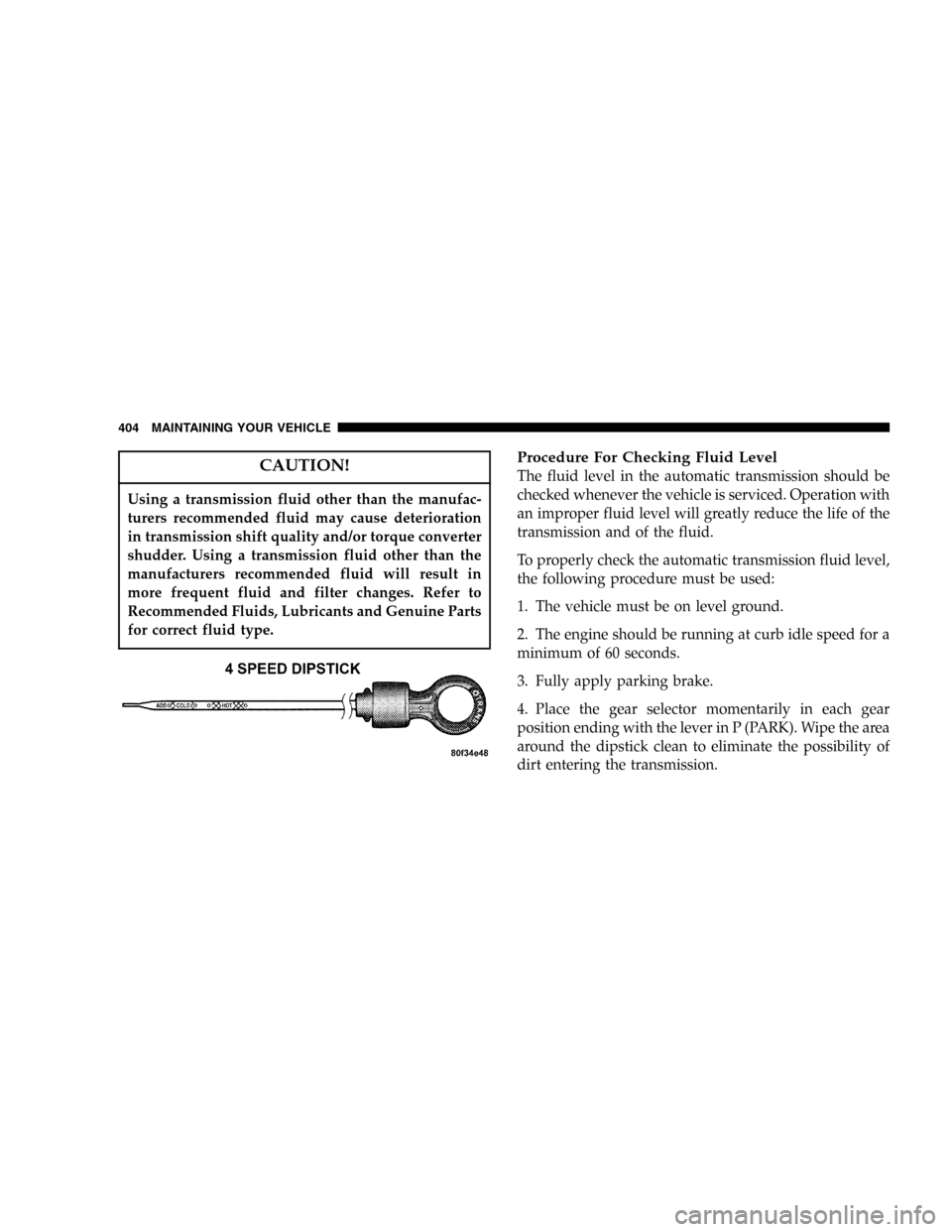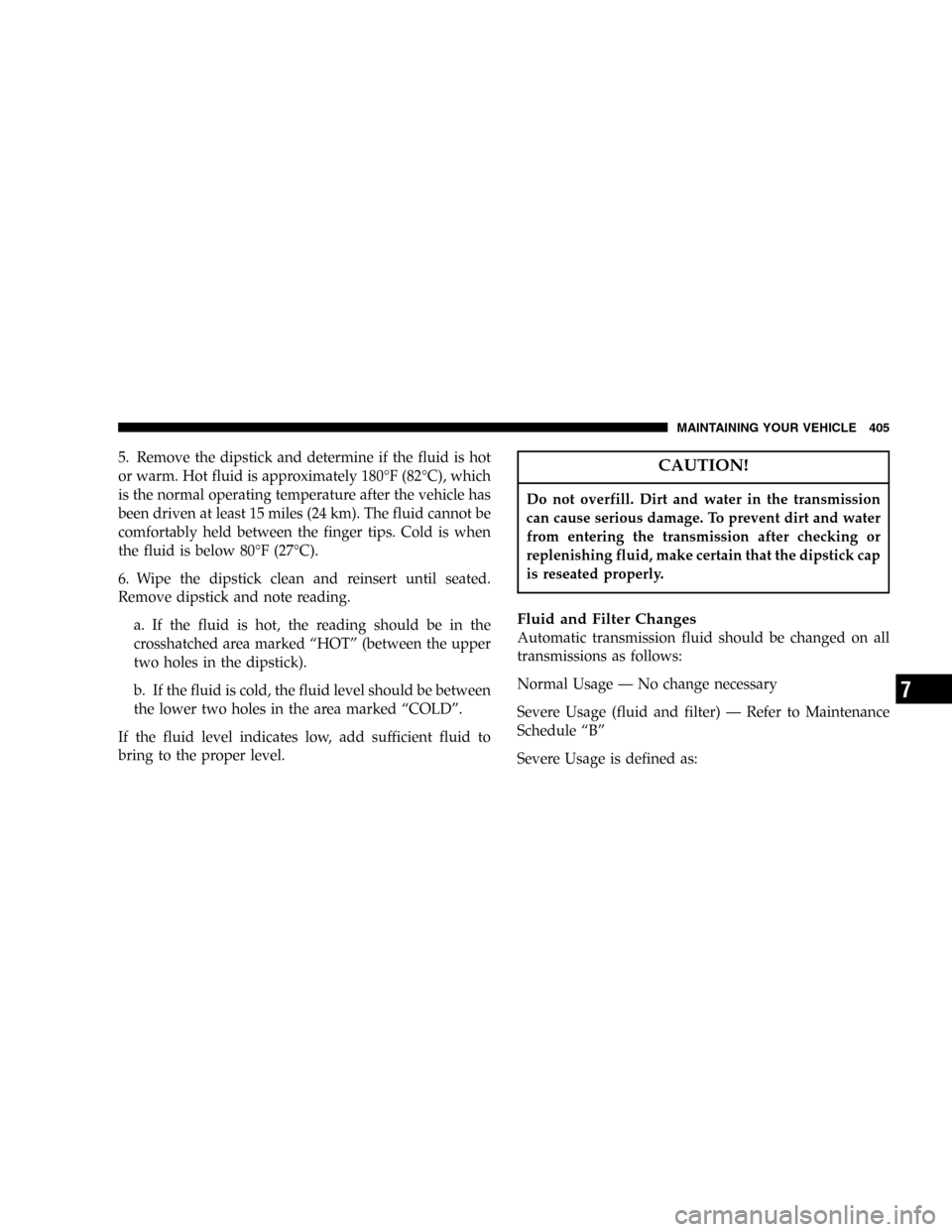Page 374 of 472

▫Steering Shaft Seal....................391
▫Steering Linkage......................391
▫Drive Shaft Universal Joints..............391
▫Body Lubrication.....................392
▫Windshield Wiper Blades................392
▫Windshield And Rear Window Washers.....393
▫Exhaust System......................393
▫Cooling System.......................394
▫Hoses And Vacuum/Vapor Harnesses.......399
▫Brakes.............................400
▫Master Cylinder—ABS Brakes Brake Fluid
Level Check.........................401
▫Fuel System Hoses....................403▫Automatic Transmission................403
▫Front And Rear Wheel Bearings...........406
▫Appearance Care And Protection
From Corrosion......................406
▫Cleaning The Instrument Panel And Underseat
Cup Holders........................411
�Integrated Power Module (IPM)............412
�Vehicle Storage........................415
�Replacement Light Bulbs.................416
�Bulb Replacement......................417
▫Headlights..........................417
▫Front Park/Turn Signal And
Sidemarker Lights.....................418
▫Front Fog Light......................419
374 MAINTAINING YOUR VEHICLE
Page 404 of 472

CAUTION!
Using a transmission fluid other than the manufac-
turers recommended fluid may cause deterioration
in transmission shift quality and/or torque converter
shudder. Using a transmission fluid other than the
manufacturers recommended fluid will result in
more frequent fluid and filter changes. Refer to
Recommended Fluids, Lubricants and Genuine Parts
for correct fluid type.
Procedure For Checking Fluid Level
The fluid level in the automatic transmission should be
checked whenever the vehicle is serviced. Operation with
an improper fluid level will greatly reduce the life of the
transmission and of the fluid.
To properly check the automatic transmission fluid level,
the following procedure must be used:
1. The vehicle must be on level ground.
2. The engine should be running at curb idle speed for a
minimum of 60 seconds.
3. Fully apply parking brake.
4. Place the gear selector momentarily in each gear
position ending with the lever in P (PARK). Wipe the area
around the dipstick clean to eliminate the possibility of
dirt entering the transmission.
404 MAINTAINING YOUR VEHICLE
Page 405 of 472

5. Remove the dipstick and determine if the fluid is hot
or warm. Hot fluid is approximately 180°F (82°C), which
is the normal operating temperature after the vehicle has
been driven at least 15 miles (24 km). The fluid cannot be
comfortably held between the finger tips. Cold is when
the fluid is below 80°F (27°C).
6. Wipe the dipstick clean and reinsert until seated.
Remove dipstick and note reading.
a. If the fluid is hot, the reading should be in the
crosshatched area marked“HOT”(between the upper
two holes in the dipstick).
b. If the fluid is cold, the fluid level should be between
the lower two holes in the area marked“COLD”.
If the fluid level indicates low, add sufficient fluid to
bring to the proper level.CAUTION!
Do not overfill. Dirt and water in the transmission
can cause serious damage. To prevent dirt and water
from entering the transmission after checking or
replenishing fluid, make certain that the dipstick cap
is reseated properly.
Fluid and Filter Changes
Automatic transmission fluid should be changed on all
transmissions as follows:
Normal Usage—No change necessary
Severe Usage (fluid and filter)—Refer to Maintenance
Schedule“B”
Severe Usage is defined as:
MAINTAINING YOUR VEHICLE 405
7
Page 428 of 472
Once a Month
•Check tire pressure and look for unusual wear or
damage.
•Inspect the battery and clean and tighten the terminals
as required.
•Check the fluid levels of coolant reservoir, brake
master cylinder and transmission, add as needed.
•Check all lights and all other electrical items for correct
operation.At Each Oil Change
•Change the engine oil filter.
•Inspect the exhaust system.
•Inspect the brake hoses.
•Inspect the CV joints and front suspension compo-
nents.
•Check the automatic transmission fluid level.
•Check the coolant level, hoses, and clamps.
428 MAINTENANCE SCHEDULES
8
M
A
I
N
T
E
N
A
N
C
E
S
C
H
E
D
U
L
E
S
Page 455 of 472

Interlock System....................... 300
Reset Mode.......................... 301
Selection Of Lubricant................403,424
Shifting............................. 301
Special Additives...................... 406
Automatic Transmission................... 403
Adding Fluid......................... 404
Fluid and Filter Changes................. 405
Fluid Change......................... 405
Fluid Level Check...................... 404
Fluid Type........................403,424
Ball Joints............................. 391
Battery............................... 387
Gas Caution.......................... 388
Jump Starting......................... 367
Keyless Transmitter Replacement............ 26
Saving Feature (Protection)............... 141
Bearings.............................. 406Belts, Drive............................ 384
Body Mechanism Lubrication............... 392
B-Pillar Location........................ 314
Brake Fluid............................ 424
Brake, Parking.......................... 303
Brake System........................304,400
Anti-Lock........................... 305
Fluid Check.......................... 401
Hoses.............................. 400
Warning Light........................ 200
Brakes.............................304,400
Brake/Transmission Interlock............... 300
Break-In Recommendations, New Vehicle........ 82
Bulb Replacement....................... 417
Bulbs, Light............................ 416
Calibration, Compass..................... 156
Capacities, Fluid........................ 422
INDEX 455
10
Page 459 of 472

Temperature Gauge..................... 203
Exhaust Gas Caution..............38,83,335,394
Exhaust System......................... 393
Extender, Seat Belt........................ 53
Exterior Folding Mirrors................... 93
Filters
Air Cleaner.......................... 385
Air Conditioning....................288,390
Automatic Transaxle.................... 405
Engine Oil........................384,423
Engine Oil Disposal.................... 384
Flashers
Hazard Warning....................... 346
Turn Signal.....................200,418,420
Flat Tire Stowage........................ 357
Fluid Capacities......................... 422
Fluid Leaks............................. 85Fluid Level Checks
Automatic Transmission................. 404
Brake............................... 401
Power Steering........................ 390
Fog Light Service........................ 419
Fog Lights..........................142,419
Freeing A Stuck Vehicle................... 370
Fuel................................. 332
Adding............................. 336
Additives............................ 334
Clean Air............................ 333
Filler Cap............................ 336
Gasoline............................ 332
Gauge.............................. 199
Hoses.............................. 403
Light............................... 200
Octane Rating......................332,423
Requirements......................332,422
Tank Capacity........................ 422
INDEX 459
10